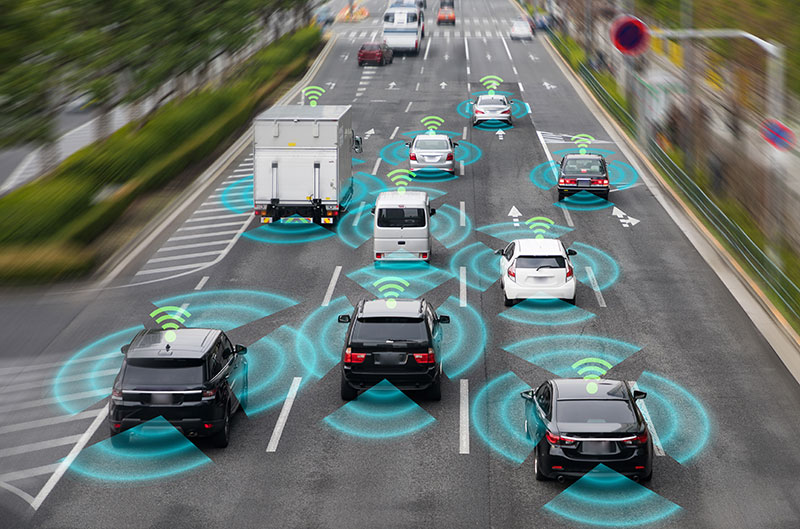VEHICLE SAFETY C-V2X
The Future of Vehicle Road Safety Using 5G
C-V2X in Cars and Trucks Will Take Autonomous Driving to the Next Level.
Cellular connectivity (“C-V2X” or cellular-vehicle-to-everything) is racing to utilize 5G to do everything from increasing road safety to opening doors. It’s estimated there will be over 100 million cellularly connected autos on the road by 2035.
Range of C-V2X Connections
Here are the 4 main types of connections:
- Vehicle-to-infrastructure – The Interconnection between cars and sectors of the public infrastructure
- Vehicle-to-network – Allowing a car to connect with cellular network infrastructures
- Vehicle-to-pedestrian – Connecting cars and pedestrian via a mobile device
- Vehicle-to-vehicle – Interconnectivity between vehicles without the need of an external network
How will 5G Maximize Security and Safety?
5G will maximize vehicle safety and security by offering enhanced mobile broadband. One exciting aspect of 5G connectivity is increased bandwidth and the freedom it’ll offer drivers.
It will also allow for ultra-reliable low-latency communication since 5G offers fast data transmission and a reliable network connection. This lays the groundwork for for massive machine-type communication.
5G allows connectivity with an astonishing one million devices per square kilometer of one another. On average, new vehicles have at least 10 sensors and cameras on board. In a traffic jam with 100 other cars, you could connect to 1,000 sensors.
Other Considerations
Multi-access edge computing offers processing of non-real time data from the car to a cloud. It frees up processing, leaving the capacity for more time sensitive data that’s needed from complex traffic scenarios.
There will also be greater long range communications. Moving cars will connect to various back ends. Drivers will experience unique network conditions but will be able to adapt its connection according to network performance. An example is an autonomous car lowering speed after entering an area with inadequate network coverage.
On-board Entertainment
With high data throughputs, 5G equips cars with broad info and entertainment capabilities. There will be streaming opportunities, enhanced gaming and reality and augmented rich navigation.
Cooperative Maneuvers
Local awareness sharing and driving intentions can be coordinated among groups of vehicles. Overall traffic efficiency and safety is coordinated. Now there’s smoother maneuvering, increased driver comfort, and reduction in fuel and emission usage.
In concept, two or more trucks could link up. The vehicles could adapt and react to traffic. It’s been estimated this type of defensive driving could decrease fuel consumption in a fleet by 30%.
Cooperative Perception
Cooperative perception entails exchanging data from sources, like sensors, that’s shared among other vehicles. Imagine using the 5G tech and connectivity to identify maneuvers between vehicles. Visibility limitations become non-existent.
Autonomous Navigation
Using a predefined region, vehicles can have real time data with hi-def maps. Semi- and fully automated cars and trucks will have optimized route selection. This reduces time in traffic. It enhances driving comfort.
Remote Driving
5G frees up advanced driving opportunities via data intensive video footage with high network and low latencies. Cooperative perception and maneuvering is enhanced with connectivity via 5G.
How to Fully Realize 5G Connectivity
It will be important to target high penetration rates to see the full benefits of 5G vehicular connectivity. This will require transportation infrastructure organizations and public authorities taking responsibility for funding cellular network infrastructure. It will be the only way to enable widespread C-V2X deployment, as well as making road traffic greener and safer.
What’s Next
Adapting to on-board 5G cellular connectivity requires a demand driver. It’s the only path to justifying an investment in C-V2X implementation. Public authorities will have to see enhancing traffic security as a necessary need for public safety. Connected car tech brings greater road security. This leads to fewer traffic fatalities and decreased injuries.
Next, the strategy will need to be international. It will have to harmonize spectrums for use in intelligent transport systems. Current initiatives connected to the Federal Communications Commission’s decision to utilize the 5.0 GHz frequency is a solid first step. It pushes the industry that much closer to C-V2X technology. It’s expected other regulators will follow the commission’s lead.


